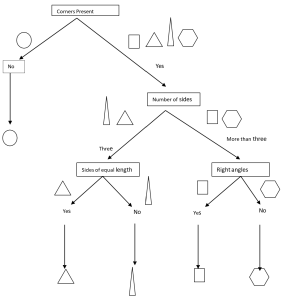33 Dichotomous Keys
Emilie Miller, Ph.D
Objectives
- Understand the uses of dichotomous keys.
- Using the test results throughout this course construct a dichotomous key for the identification of a bacterial unknown.
Introduction
Keys that are based upon successive choices between two alternatives are known as dichotomous keys (dichotomous means to “fork into two equal parts”). One use of a dichotomous key is to organize large amounts of information so identifications can be made more easily. This method is used to characterize and identify living organisms, including bacteria.
The first step in the identification of an unknown bacterium is often to determine its morphology and Gram stain reaction. This allows you to eliminate many possibilities (for example, a Gram negative bacillus is not Staphylococcus aureus or Bacillus subtilis). After determining the Gram reaction and morphology of an unknown organism, you can eliminate many possibilities, but will likely still need additional tests to determine which species you have (remember that there are lots of bacteria that look the same under the microscope).
Sometimes, additional staining (like acid-fast or endospore staining, for example) can be used to further characterize bacteria. In this exercise, you will be using the metabolic tests you have learned about in Lab 5 to design a dichotomous key that will allow you determine which tests can be used to distinguish the 10 bacterial species we are using in the lab from each other. You will then be using those tests to identify your two unknowns for your midterm practical.
Procedure Your instructor will show you an example of a simple dichotomous key using geometric shapes (see below). The key is based on looking for features that distinguish one shape from another. Similarly, unknown bacteria can be identified by looking for tests that distinguish one type of bacteria from another based on their different properties. Dichotomous keys for bacterial unknowns are based on Gram reactions, morphologies and metabolic assays like the ones you have learned in lab. Once you understand the concept of developing a dichotomous key, you will design your own keys that will allow you to identify your particular unknowns based on these characteristics. There are many ways to make a useful key, so your key may not resemble those made by other students.


